Your Day of the Dead Altar can be an amazing way to celebrate Dia de Los Muertos this Fall. Honor your relatives with this truly authentic Mexican tradition.
This post may include affiliate links. As an Amazon Associate I earn from qualifying purchases.
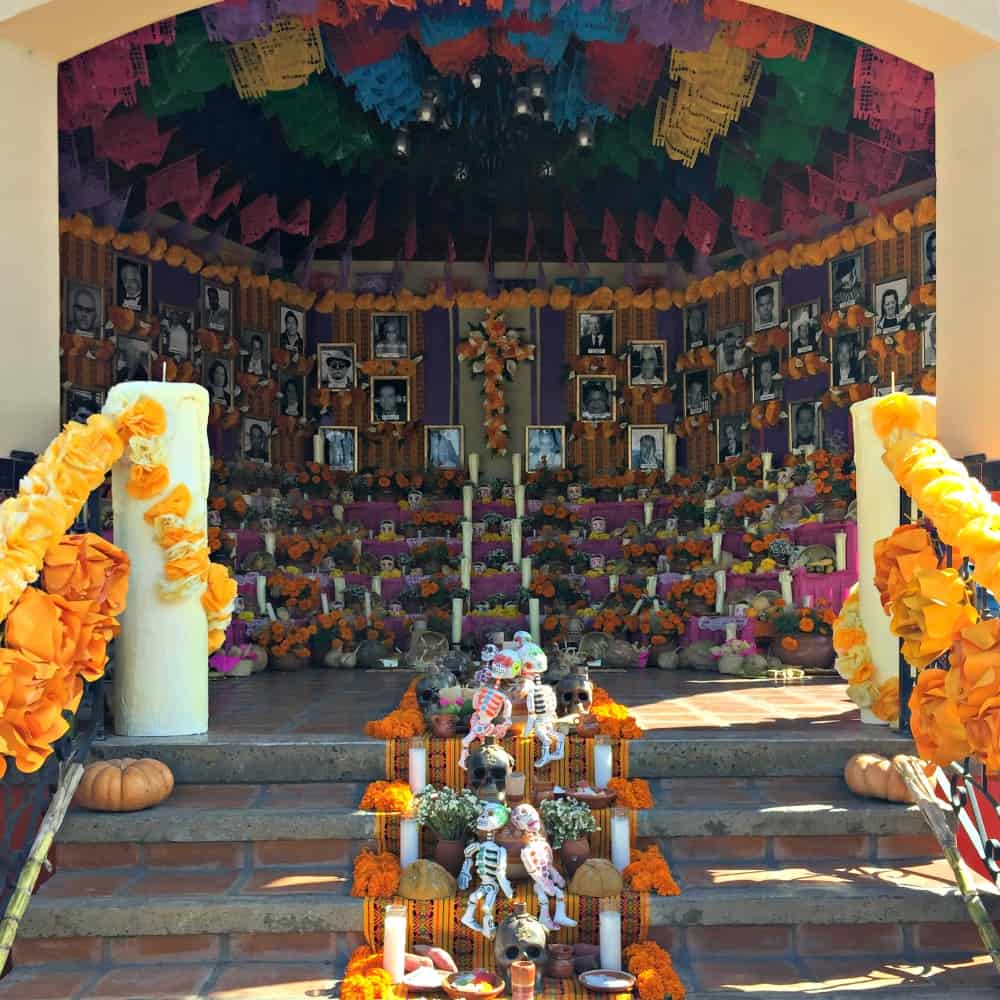
Table of Contents
What is Dia de los Muertos?
Día de los Muertos, or Day of the Dead, is a festival of love, respect, and a day of remembrance. It is a true jewel in Mexico’s cultural crown, and a special way of keeping the spark of our departed loved ones alive. Even though they’ve embarked on their journey from the land of the living to the spiritual realm, they are still always with us.
Kickstarting on October 31st, right up until November 2nd, Día de los Muertos shares the calendar with All Saint’s Day as well as All Souls Day, two Catholic traditions. But here’s the secret sauce – the spirit of Día de los Muertos isn’t limited to these dates. It’s a lasting tribute to the unbroken cycle of life and death that keeps the heart of our culture beating.
Woven into Mexico’s indigenous traditions, this holiday traces itself back to the Aztecs’ reverence for and worship of the dead. Ancestor worship, integral to Aztec beliefs, painted death not as an end but as a transition to another life.
The Elements of the Altar
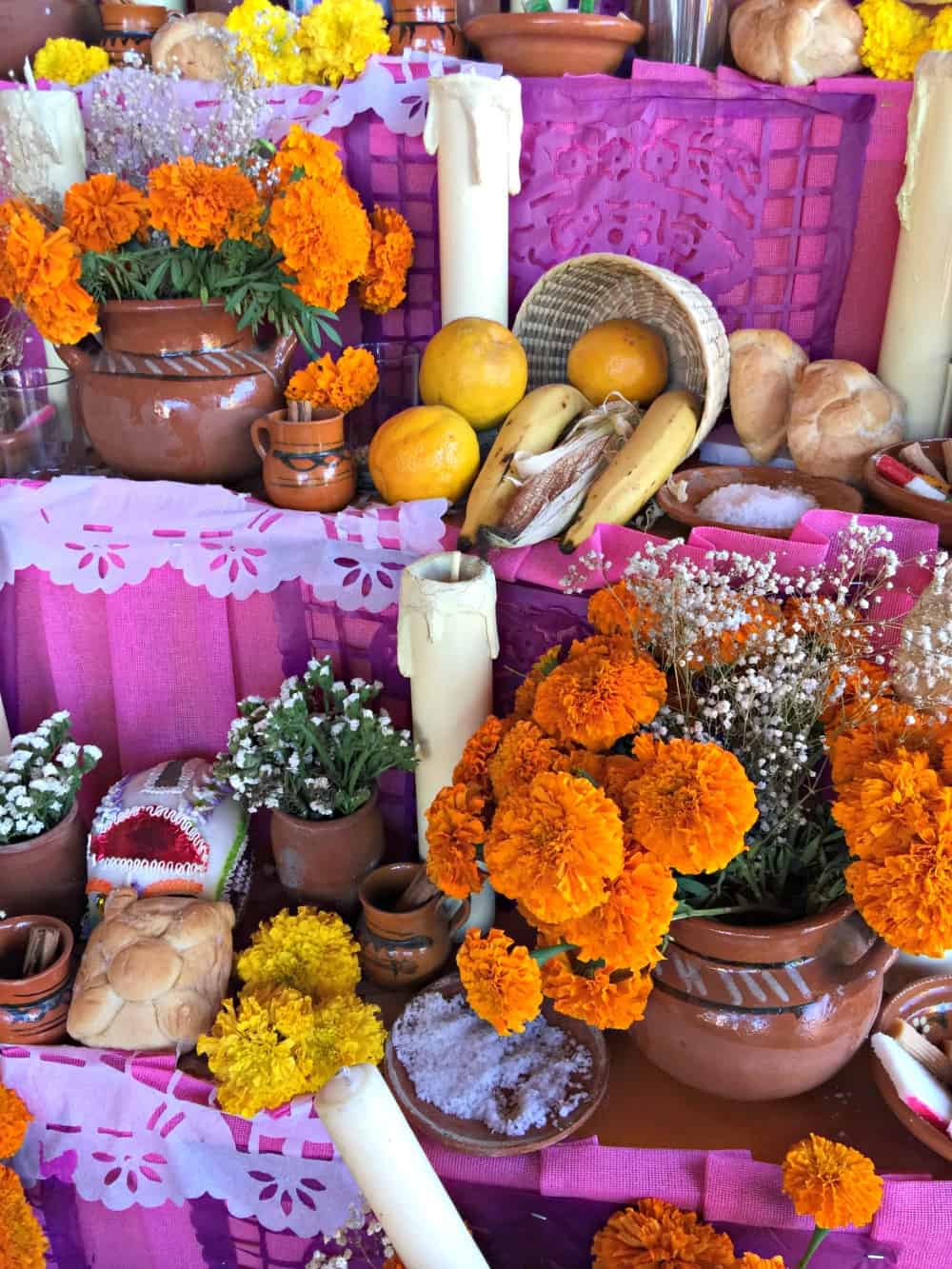
At the core of the celebrations is the creation of an elaborate Day of the Dead altar, or ‘ofrenda.’ These altars are sacred spaces, exploding with bright colors and filled with symbolic offerings, designed to welcome the spirits back home.
Every ofrenda is a unique work of art, mirroring the personality of the departed person, whose soul is believed to visit during these festivities.
If creating an altar seems overwhelming, have no fear! The most important elements of an ofrenda are love and memory.
⛪️ The Cross
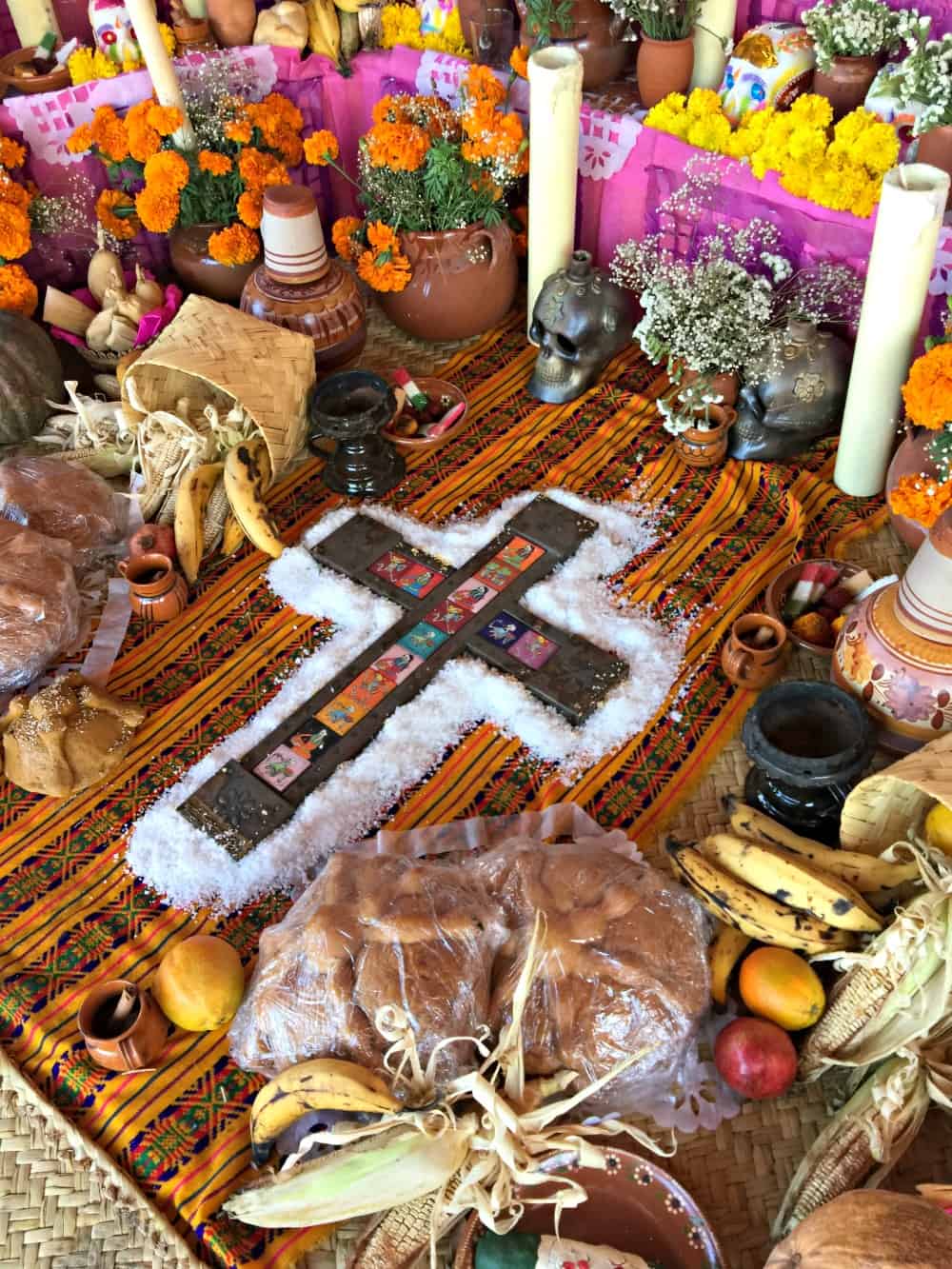
When it comes to the arrangement of the altar, different regions and even different families can have their unique practices. However, it’s common to see the items arranged in the form of a cross, another nod to the blend of indigenous beliefs and Catholicism. This pattern is said to represent the cardinal directions—north, south, east, and west—with each direction having a different significance and corresponding element: wind, water, earth, and fire.
🧂 Salt
Although Day of the Dead holiday has evolved over many years, there are some customs that never die. Like salt! In many Mexican traditions, salt is considered a purifier that helps cleanse the spirits and ward off evil.
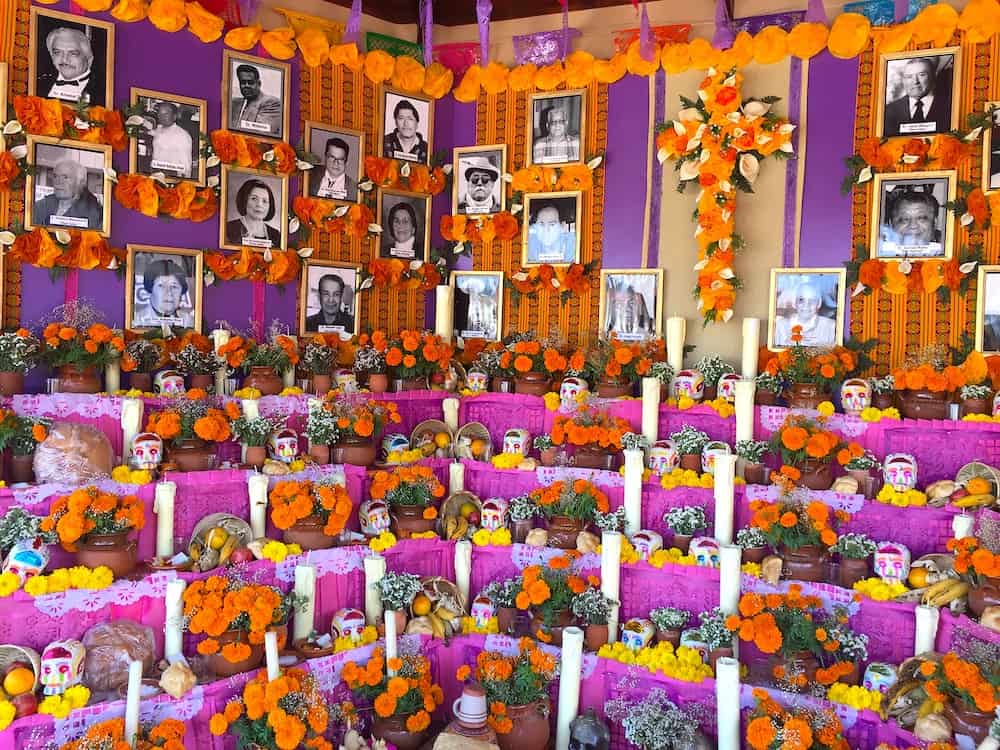
🕯️ Candles
Another common yet profound element is a lit candle for each dead person. The flickering candlelight symbolizes hope and faith and is believed to light the path for the souls, guiding them from the spirit world back to the land of the living.
A lighted candle is usually placed at each point of the cross, representing the light that guides the spirits back home. The flickering flames add warmth to the bright, vibrant colors of the Day of the Dead altar. They also give a sense of transience, a reminder of the fragility and impermanence of life.
Colors
You might wonder about the bright colors that are so prominent in Día de los Muertos celebrations. These colors, especially orange and purple, have particular significance. Orange is said to represent the sun and vitality, while purple stands for grief and suffering. This blend of joy and sorrow, of life and death, is at the heart of this holiday.
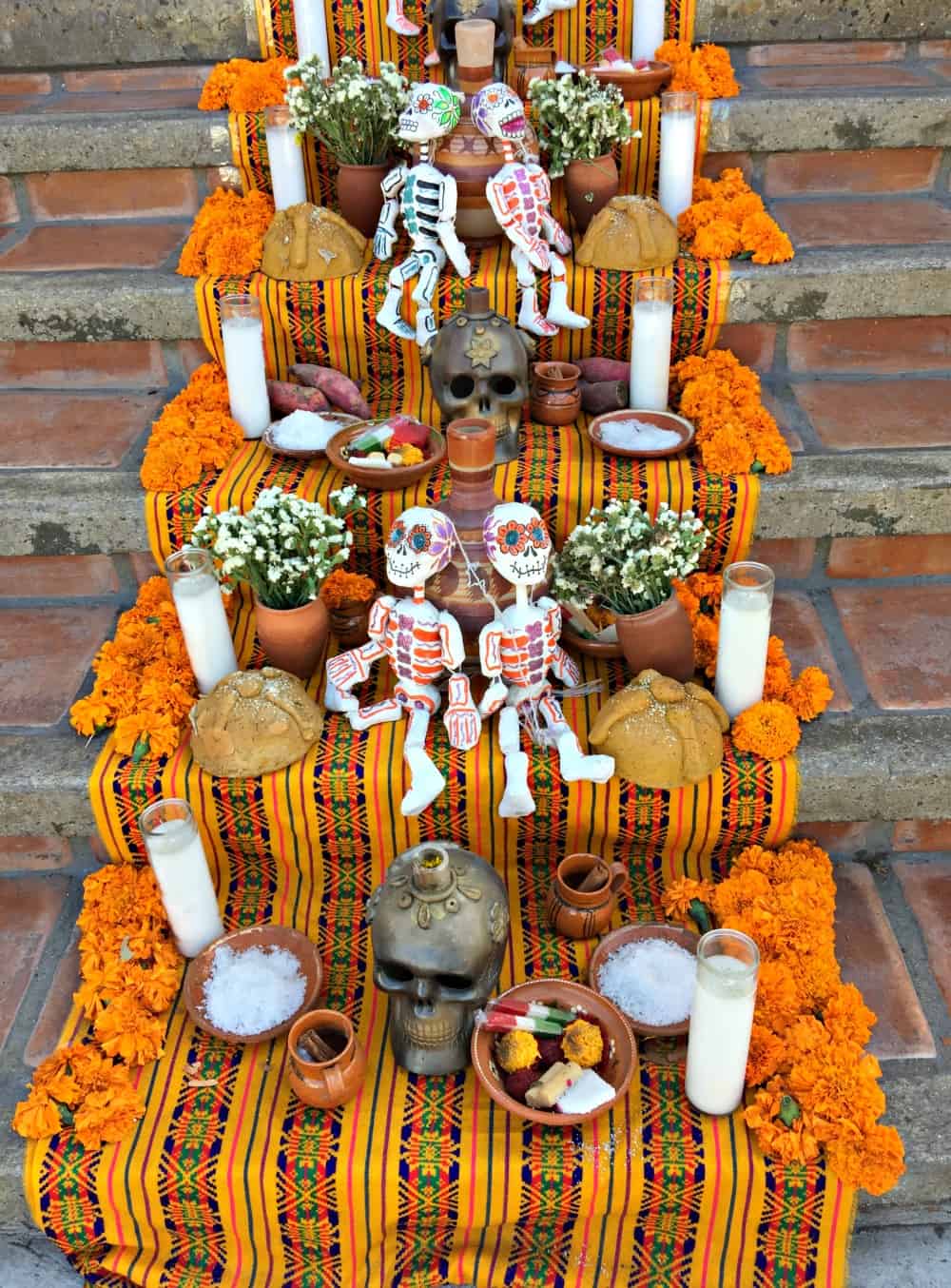
Different Levels
Altars traditionally consist of different levels, each representing different regions of the afterlife. The highest level, the realm closest to the spirit world, proudly displays photographs of our dearly departed, making them the centerpiece of the altar.
The lower levels are adorned with intricately cut tissue paper artworks or papel picado. These colorful paper banners add a touch of whimsy to the solemn occasion and represent the fragility of life. It’s believed that the airflow through the delicate patterns of the papel picado brings to life the souls of both children and adults, guiding them back home.
💦 Water
No altar is complete without a glass of water. A simple yet potent symbol of life’s elements, it quenches the spirits’ thirst after their lengthy journey from the spirit world, and its purity serves to cleanse and purify the environment. Traditional elements like these can be spotted on grand, community-built altars in public places across Mexico City and other regions of central Mexico.
🥘 Traditional Foods
Next, let’s explore the vibrant and tantalizing world of food – one of my favorite subjects. In keeping with our Mexican traditions, the favorite foods and dishes of the departed are prepared with love and placed on the altar. This could range from mouth-watering tamales to bottles of tequila.
Pan de Muerto

One of the most common elements you’ll find on every Día de los Muertos altar is Pan de Muerto, or Bread of the Dead. This sweet round loaf symbolizes the sweetness of life and adds an authentic touch to the celebrations.
Pan de muerto, or Bread of the Dead, traditionally baked for Mexico’s Day of the Dead, is a soft and sweet bread that’s simply irresistible! Its delicate orange flavor and buttery richness make it a must-have treat during the Día de Muertos celebrations.
You might also see other desserts on the altar like Conchas, Mexican Buñuelos, and Mantecadas.
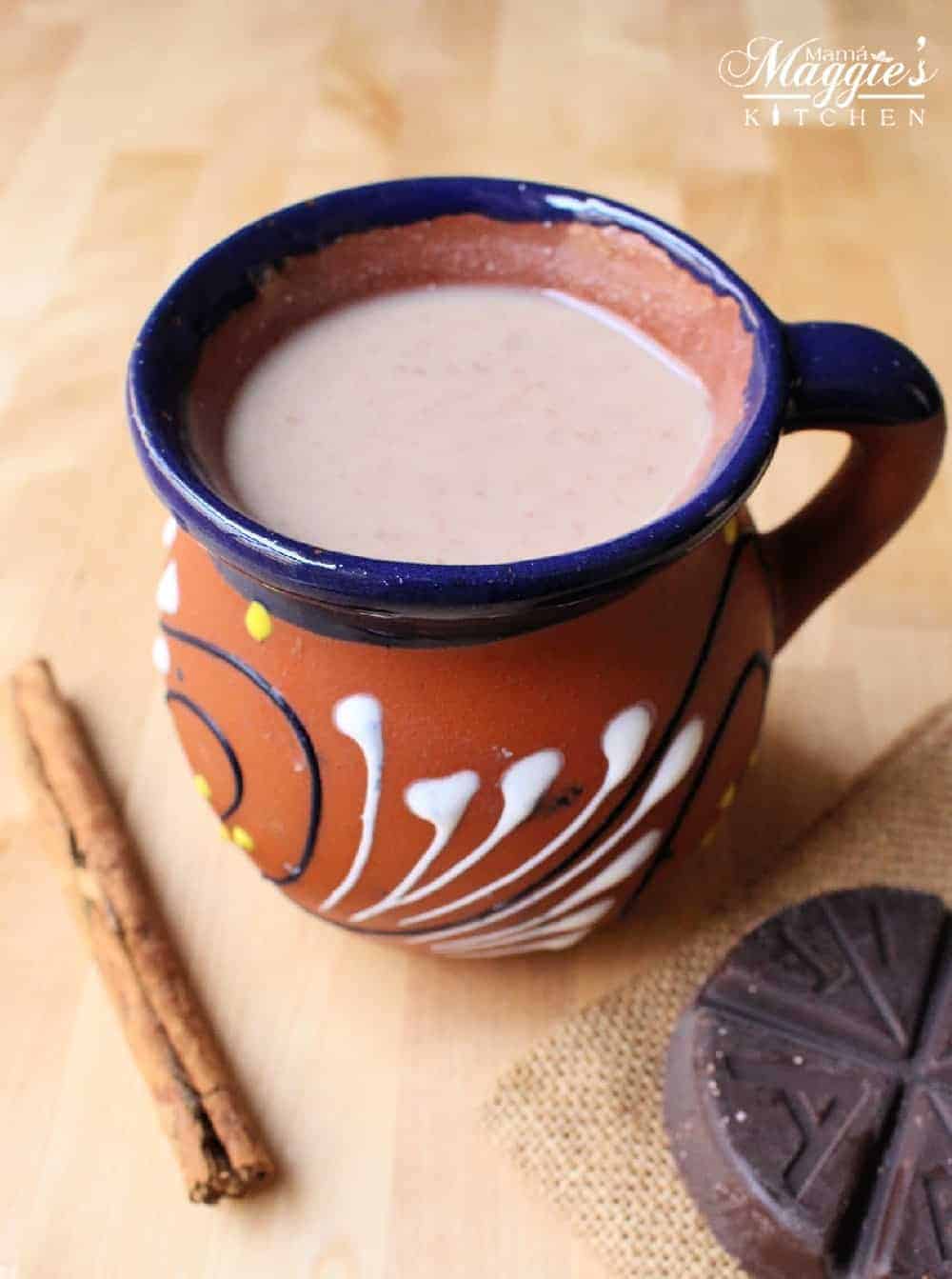
Aside from desserts, people will make their loved ones their favorite foods. Recipes enjoyed while they were still alive like Asado de Puerco, Enchiladas Rojas, Menudo Recipe, or Red Pork Tamales .
It’s not uncommon to see Tequila bottles, beer bottles, or juice boxes. Other traditional drinks include Champurrado, Atole de Guayaba, and Atole de Arroz.
Along with the items already mentioned, other common elements you’ll often see on an ofrenda are fall fruits and seasonal treats. This is a bountiful time of year, and the abundance of fresh produce reflects the sweetness and joy of life. Similarly, the favorite dishes of the departed are also prepared with love and placed on the altar. From tamales to the deceased’s favorite tequila, these food offerings represent the earthly pleasures that the spirits are believed to enjoy on their brief return.
💀 Sugar Skulls

It’s hard to overlook the intricate sugar skulls that adorn the altar. Each one is carefully decorated and often labeled with the name of the departed, serving as a sweet reminder of their enduring presence in our lives. These colorful skulls add an element of fun to the occasion and are loved by children and adults alike.
Despite the practices and traditions varying across different regions of Mexico and the United States, creating your own Day of the Dead altar remains a unique way to honor your cultural heritage. Whether in Mexico City, Central Mexico, or Southern California, this rich tradition brings people together, reminding us of the cyclical nature of life and death.
La Catrina
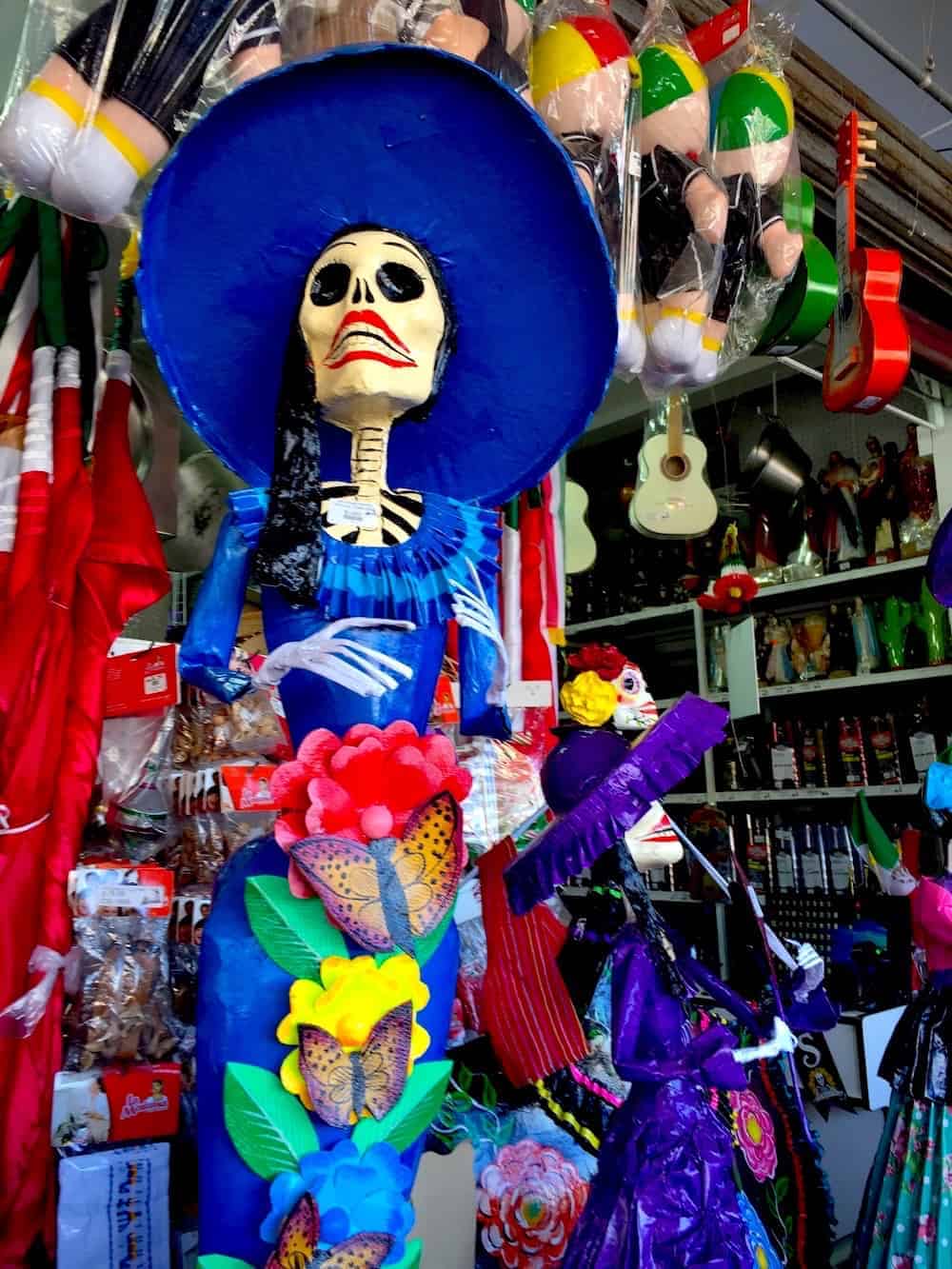
An unforgettable symbol of Día de los Muertos is La Catrina. Each Fall, this fashionably attired skeleton lady emerges, turning heads in her fancy hats and elaborate dresses. She’s a symbol deeply rooted in Aztec traditions, where ancestors were seen not as lost, but merely journeying into the next life.
During Día de los Muertos, La Catrina, in her signature long dress, stylish shoes, and feathered hat, takes center stage. Her likeness is reflected in the makeup and costumes of many women during the celebrations. You’ll even find a dazzling array of La Catrina statues at Mexican markets – a testament to her popularity.
Skeletons
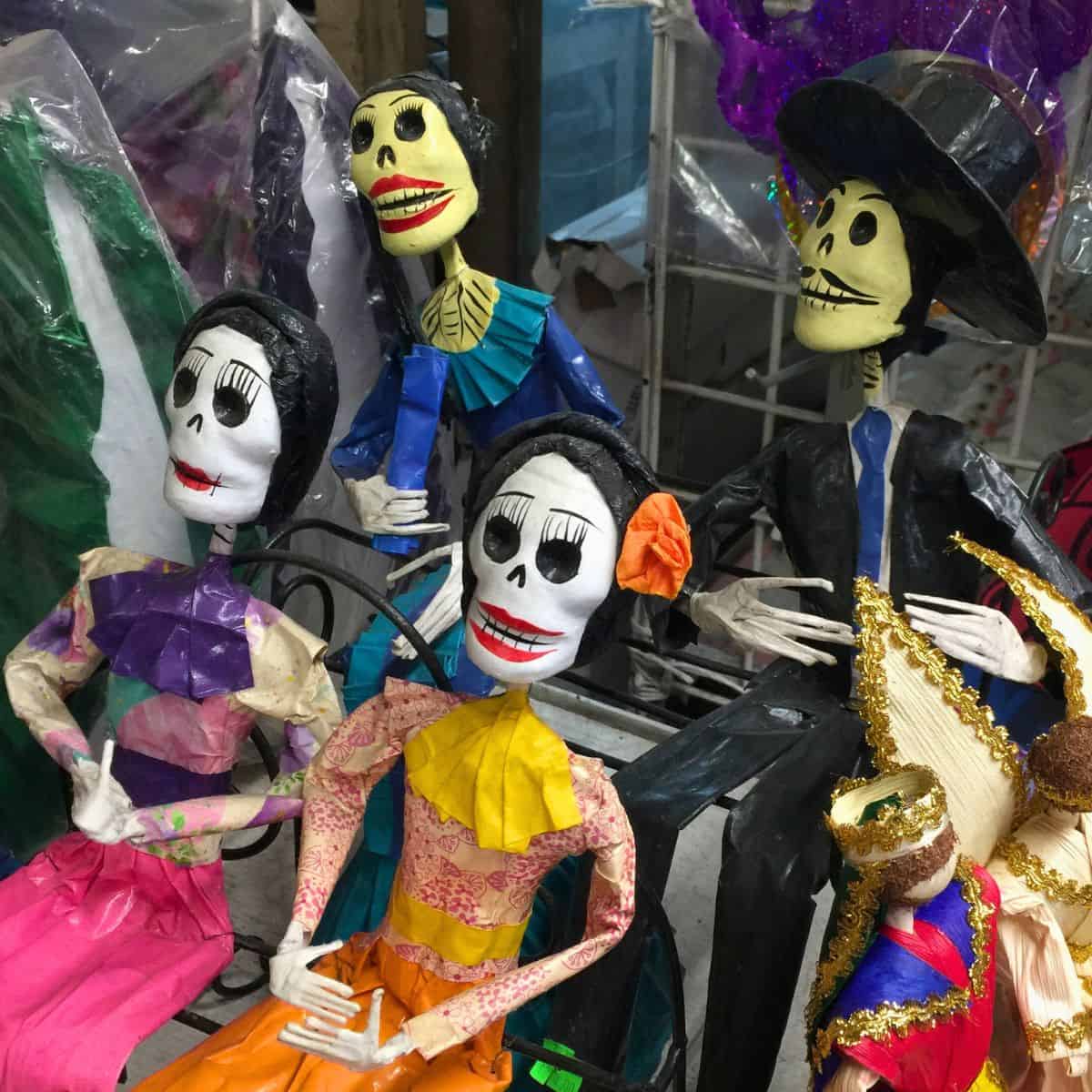
From November 1st, “Day of the Innocents,” through November 2nd, “Day of the Dead,” La Catrina and other skeleton figures grace our celebrations.
These skeletons are typically figures that resemble the personality of the deceased. Their presence reminds us of the unbroken bond between the living and the departed, transforming Día de los Muertos into a vibrant celebration of life and death.
In addition to food, personal belongings of the deceased are also placed on the altar. These could be anything from a favorite book to a beloved piece of jewelry, even a cherished tool from a profession or hobby. The idea is to create a familiar setting for the visiting spirits, making them feel at home.

Symbols of our traditional Catholic religious beliefs are also commonly displayed on the altar. You’ll often find images of saints and the Virgin of Guadalupe. These divine figures represent spiritual guidance for the spirits during their visit, reminding us of the profound faith and deep spirituality tied to this tradition.
🌼 Cempasuchil (Marigold flowers)
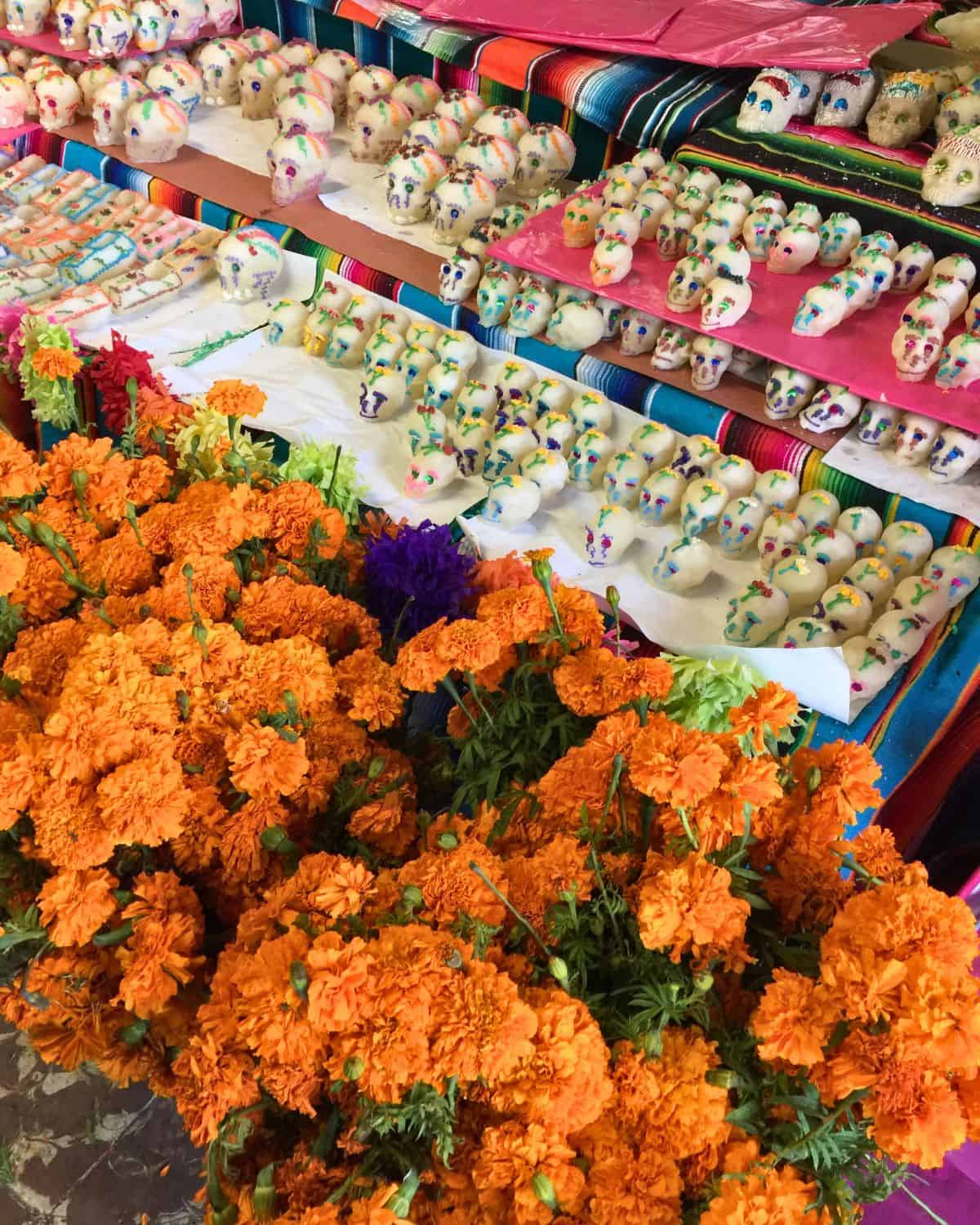
To further enhance your Day of the Dead altar, you could include the delicate ‘cempasuchil’ or marigold flowers, also known as ‘flor de muerto.’ These flowers, with their vibrant orange color and strong scent, are believed to guide the spirits on their journey from the spirit realm. Their fragrance, combined with the sweet scent of copal incense, fills the air, creating a mesmerizing atmosphere.
This incense is believed to cleanse the air of any negative energy, guiding the spirits with its powerful fragrance. The smoke from the copal incense wafts through the air, adding to the solemn, respectful, and somehow also jubilant atmosphere.
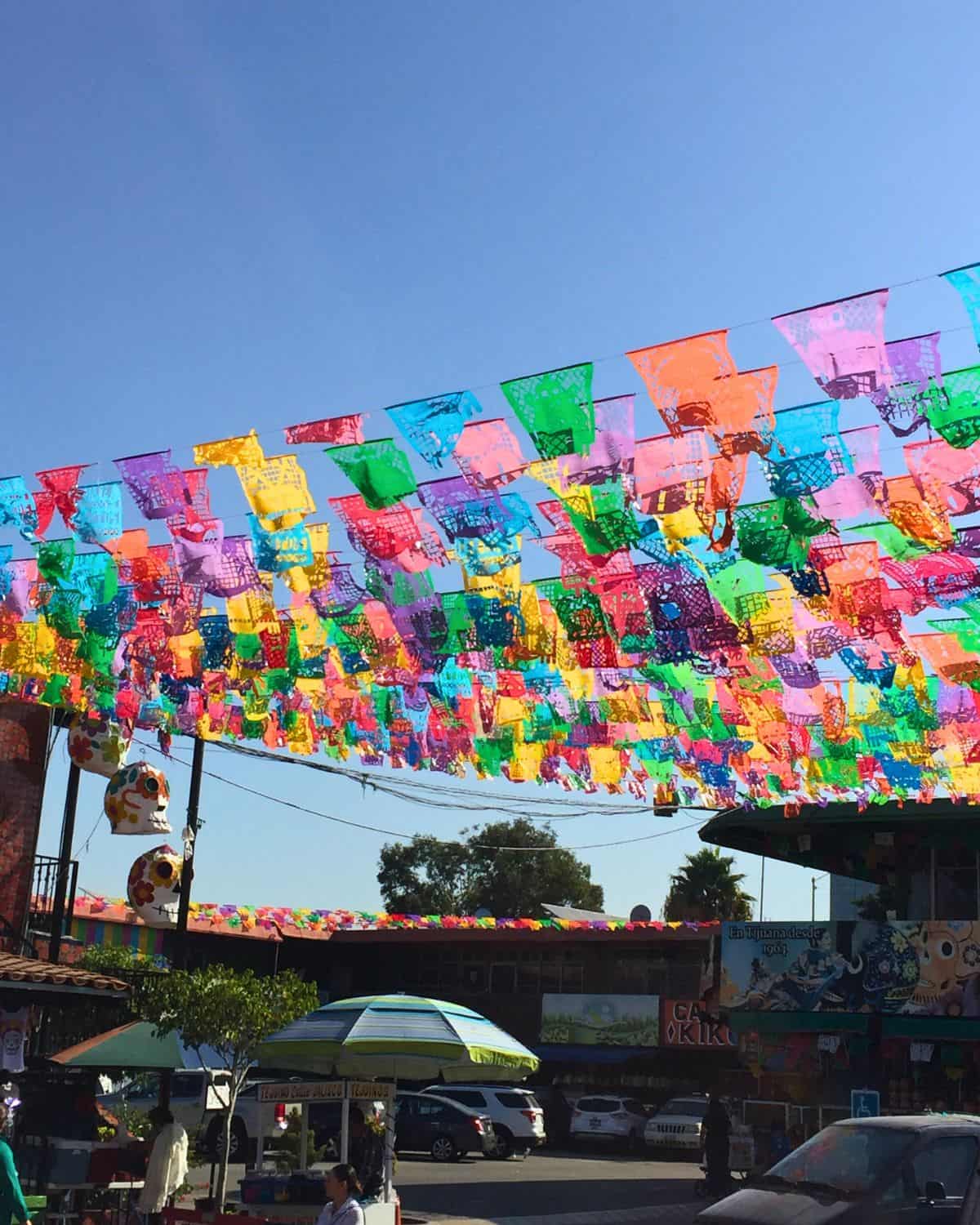
In Mexico, altars in public places are a common sight. These are usually quite large and elaborate, reflecting the collective effort of the community. While each altar is unique, they all incorporate the traditional elements we’ve discussed so far, along with others that are unique to the specific region or even the individual family.
The Day of the Dead is a profoundly personal and family-oriented holiday, and each family’s ofrenda is a reflection of their love, their loss, and their lasting memories. This joyous celebration serves as a reminder that death is not the end, but simply another stage in the cycle of life.
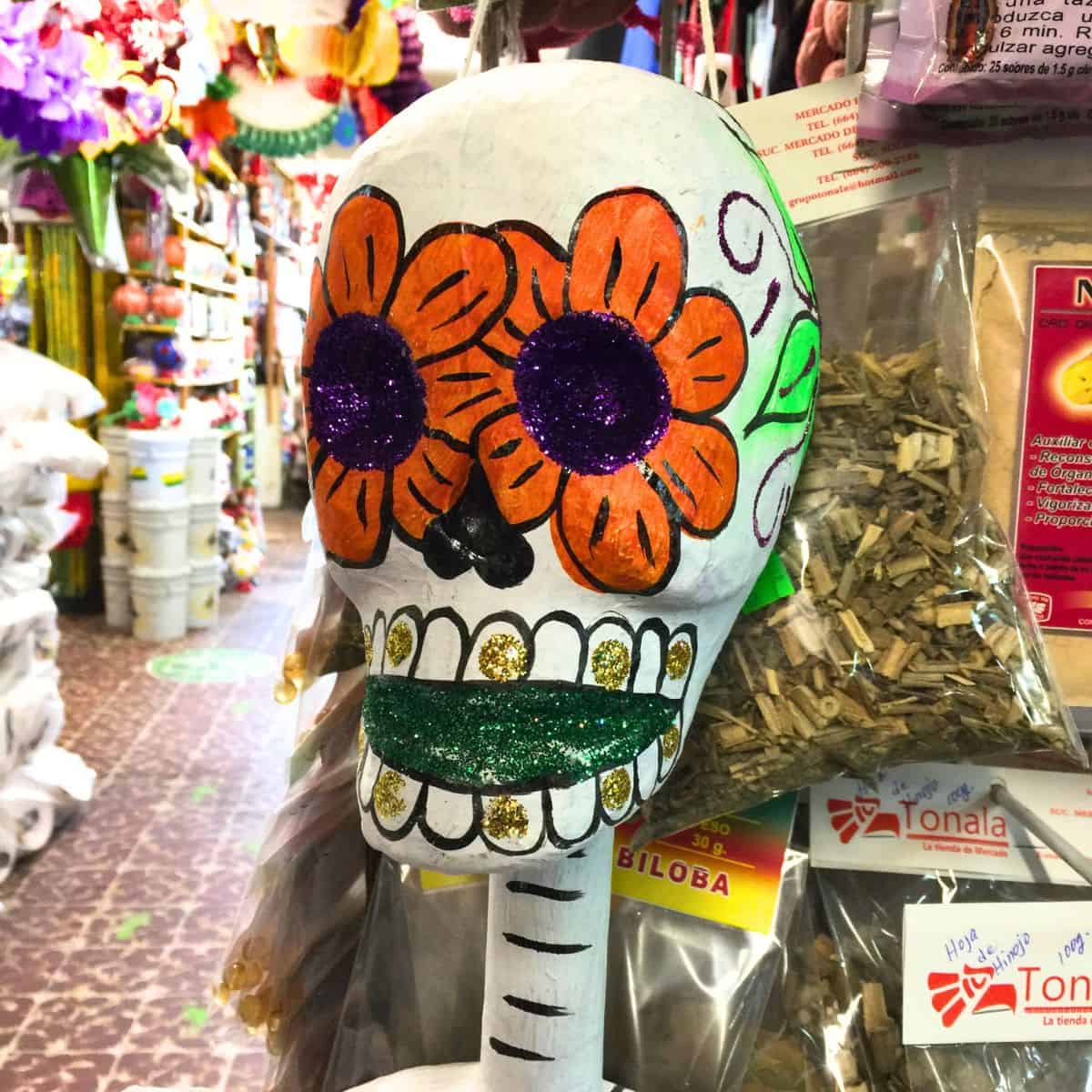
Finally, I would like to leave you with a thought. Despite the sadness that comes with loss, Día de los Muertos is a celebration of life. The bright colors, the delicious food, the joyful music, and the familial love all serve to remind us that our time in the land of the living is precious. So, let us honor those who have come before us, and celebrate the life that we still have.
Stay blessed, stay curious, and keep the celebration of life going in your hearts and kitchens.
😋 Hungry for More?
Be sure to subscribe to my newsletter and follow along on Facebook, Instagram, Pinterest for my latest recipes and videos.


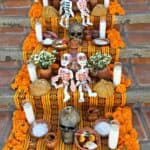
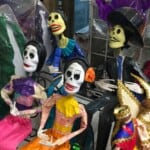

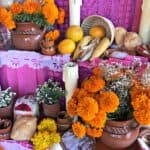
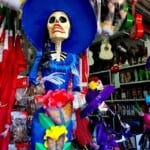
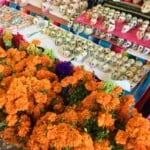
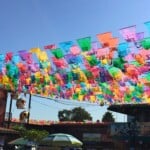
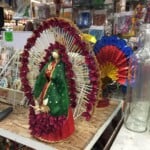
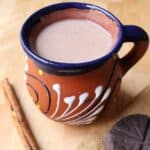

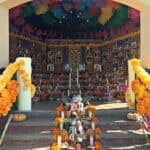
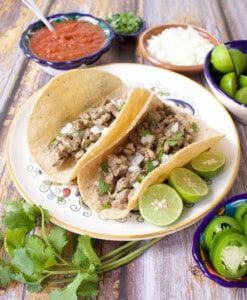
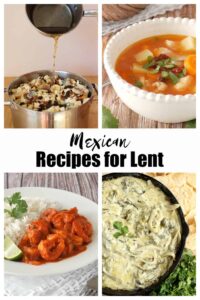
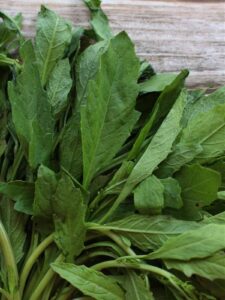
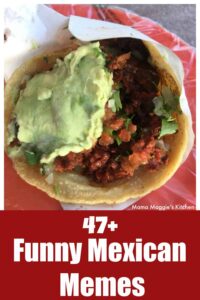
I have a good time reading this post. I have learned a lot about this tradition and how important it this to many people!
Thank you. It’s a beautiful tradition. Each of the Day of the Dead Altars are very unique.
This is such a neat idea. I like how it is put together and how it is thoughtful in following the history and beliefs behind the Day of the Dead traditions.
Thank you. Yes, it’s a beautiful tradition. I love seeing all the Day of the Dead altars. Each one is very unique.
I found this post to be very interesting and informative, and I really enjoyed reading it.
Thank you. I’m glad you enjoyed reading about the Day of the Dead altar.
Your Day of the Dead Altar is a beautiful and meaningful tribute to this important tradition. Thank you for sharing this glimpse into your cultural heritage and the significance of Dia de los Muertos. It’s truly inspiring!
Thank you. I love the look of this Day of the Dead Altar. Each one is unique and very special.
Wow! Thank you for all these details about each aspect of this fascinating festival. I have always been drawn to it for the concept the color and the cultural context and of course, Coco
Glad you enjoyed the deep dive into the Day of the Dead! It’s truly a vibrant tapestry of culture, color, and meaning.
I love how you broke this down for others to understand the culture behind Day of the Dead Altar. I think it’s great how they celebrate their loved ones.
The Day of the Dead is indeed a beautiful celebration of love and memories. Glad you liked it!
interesting post thanks for sharing about this holiday
Glad you found the post informative. Always happy to share the wonders of Mexican culture!
Wow! So colorful and amazing! I would love to see this in person. Such a nice tradition
The colors and vibrancy are something else! Glad you appreciate this beautiful tradition.
This is all so beautiful. I think this has always been a great way to celebrate those who we have lost.
Absolutely! It’s a beautiful way to celebrate and remember our loved ones.
I love how this turned out. I love that it’s a celebration of life.
Me too! It’s a lovely tradition that’s truly Mexican.
I love this tradition. What a wonderful way to celebrate our beloved who have departed!
I agree. I love seeing the Day of the Dead Altars. Each one is different and carefully assembled with a lot of care.
Learning more about the culture of others is always an interesting and eye-opening experience. This post is truly educational.
Thank you. I hope more people learn about this beautiful Mexican tradition.